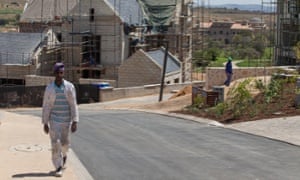 Graça Machel sank to her knees and patted earth around the base of a 2m-high bushwillow tree seeded by her late husband, Nelson Mandela, nearly eight years ago. “Trees, I think, celebrate much better his life, and his presence, perhaps better than a statue,” she mused. In bright sunshine, Machel took a glass of champagne and poured a little on the clipped grass, explaining that this was her husband’s custom at a celebration.
Graça Machel sank to her knees and patted earth around the base of a 2m-high bushwillow tree seeded by her late husband, Nelson Mandela, nearly eight years ago. “Trees, I think, celebrate much better his life, and his presence, perhaps better than a statue,” she mused. In bright sunshine, Machel took a glass of champagne and poured a little on the clipped grass, explaining that this was her husband’s custom at a celebration.
And so Steyn City, four times the size of Monaco, two and a half times bigger than New York’s Central Park and the largest development of its kind in Africa, officially opened on Tuesday. Among the boasts of this “lifestyle resort” are more than 1,000 acres of parklands, the most expensive house ever built in South Africa, a golf course from all-time great Jack Nicklaus’s design team and plans for two shopping malls, sports facilities, a school, a medical facility and a retirement village. By 2018, it will have cost 6.5bn rand (£352m).
To its creators, the mega-project north of Johannesburg embodies a “dream lifestyle” where pedestrians and cyclists take priority, children can play on a skate park among sculptures of giants, and a range of properties – from one-bedroom flats to opulent mansions – allows for a racially diverse mix of residents. And, they say, it had the blessing of the country’s first black president. Mandela was a friend of the city’s founder, billionaire insurance magnate Douw Steyn, and attended the launch of the plans here in 2007.
But, to detractors, Steyn City is the chilling development of a trend that has seen the wealthy in South Africa, fearful of violent crime, retreat into high-security gated communities cut off from the rest of society. This, critics say, is bound to reinforce an “us and them” mentality in what is already one of the world’s most unequal societies. Patrick Craven, spokesman for the Congress of South African Trade Unions, said: “It is almost a form of apartheid, not in a strictly racial sense, though in practice those who are the target of restrictions into certain areas tend to be black people.”
Steyn City appears to invite such criticism because of its jarring proximity to Diepsloot, a sprawling informal settlement where some 200,000 people liveamong shacks, uncollected rubbish, unpaved roads and criminal gangs. But its developers are ready to tackle the charge head on, arguing that the estate’s location has enabled it to hire workers from Diepsloot and provide them with skills.
Giuseppe Plumari, an Italian-born property developer who acquired the land and is now chief executive of Steyn City Properties, said: “The development is at the doorstep of Diepsloot. That’s the very thing we’re criticised for – opulence next to poverty – but that’s exactly where developments should be to empower people to get jobs, so they don’t have to spend half their salary on transport.
“Let’s applaud the wealthy man who comes to South Africa to build on the doorstep of Diepsloot and let’s vilify the wealthy man who runs away. Who’s going to make a difference to the people? I would kiss Bill Gates’s feet if he came and built a house in Diepsloot. It would create a lot of jobs.”
Plumari was speaking at an upmarket deli overlooking a swimming pool where offerings included Danish pastries, Turkish delights, devil’s rose chocolate cake, red velvet cake and carrot and caramelised nuts. The site was previously a quarry, while other parts of Steyn City contained an informal settlement of 20,000 people. Plumari said: “We worked with the government to move them to 5,500 permanent homes built last year and 99.9% of them were ecstatic.”

Officials claim Steyn City has created 11,800 jobs to date and, with just 7% of the entire development completed so far, there will be many more in future. On Monday, in an underpass, Martin Umali was among a team of artisans working on a tiled mosaic. Umali, 37, a Zimbabwean living in Diepsloot, said it only takes him 10 minutes to get to work by minibus. For him, the clash of rich and poor was not a problem. “Our next focus in Diepsloot is to expand to the youth so that kind of poverty will go away: use your hands and don’t expect the government to do everything,” he said.
Nearby, amid a cacophony of drilling and hammering, men in hard hats and blue overalls beavered away on a construction site that will one day be a shopping mall. Yet surrounding it were advertising billboards dominated by white faces – a detail likely to add to the unease about the social demographic of Steyn City.
The estate has planning approval for up to 10,000 residences, ranging from one-bedroom apartments for 1.65m rand (£89,000) to show homes costing between 16m rand (£864,000) and 22m rand (£1.2m). Plumari insisted 80% of the properties will be apartments. “It will be a racially diverse cross-section of society. A single mother and her children will rub shoulders with everyone on the estate.”
Plumari said the design is an antidote to big cities like Johannesburg dominated cars, highways and high walls. Steyn City will feature crescents, cul-de-sacs and a network of footpaths, while every house will have open borders to a park and road. “What inspired me more than anything was London’s Hyde Park,” Plumari explained. “The people who live there can roam around the park and we’ve tried to replicate that. In London you walk out of your house and meet your neighbour; in Johannesburg I don’t know my neighbour.”
The attempt to emulate Britain will even include unarmed “bobbies on the beat”, Plumari added, although more conventionally South African security measures include a 3m perimeter wall with electrified fencing and “intrusion detection technology”, CCTV surveillance “including advanced video analytics”, “a state-of-the-art security nerve centre and control room” and “integrated biometric, RFID tag and licence plate recognition access control technology”.

Steyn, 62, launched Auto & General in South Africa in 1985 and moved to the UK to start the Budget Insurance company in 1992. Mandela wrote part of his autobiography, Long Walk to Freedom, at Steyn’s home. On Tuesday, in a white marquee with four bowls of white lilies and white roses, a photo of Mandela – whose clan name was Madiba – shaking hands with Steyn was prominent as a school choir sang the national anthem. “If you look at the weather and the sunshine, I really feel Madiba’s presence today,” Plumari told the gathering. “We thank Madiba for endorsing the resort.”
Machel described Mandela’s relationship with Steyn as one of father and son. Mandela died in 2013 while Steyn, absent on Tuesday, is suffering from an illness that family and colleagues were reluctant to disclose. He already lives on the estate with his wife, Carolyn, an actress, in a Tuscan-style villa estimated to have cost 250m rand (£13.42m) – thought to be the most expensive property in South African history.
Despite ongoing controversy over expensive security upgrades to president Jacob Zuma’s own home, and a recent Oxfam reporting showing that one in four South Africa goes hungry on a regular basis, the governing African National Congress has thrown its weight behind Steyn City. David Makhura, the premier of Gauteng province, told guests that he played golf there – often seen as a symbolic pastime for the country’s emerging black middle class – and described it as “catalytic” for the area and “one of the shining examples of business working with government to change lives”.

He said: “I know there are those who say, ‘Premier, why do you speak about a development for the super-rich?’ I say, you don’t understand. Firstly, an injection of the amount of money put in the provincial economy, in our country’s economy, in the initial phase of development: more than 6 billion rand. And the number of jobs already created has made a big impact on the economy this side: 11,800 jobs.”
He added: “It integrates people who have been left out of our economy. That is something Madiba would be smiling about.”
But opposition parties condemned the development. Godrich Gardee, secretary-general of the Economic Freedom Fighters, said: “Our people in Diepsloot and other informal settlements do not want to be just workers. It’s about land and homes. Golf estates and shopping centres are taking over the land of the people. We have enough golf estates already – do we really need another one?
“I do not think it’s in the best interests of the country if the state continues to provide land to the wealthy at the expense of the poor and the downtrodden.”






























